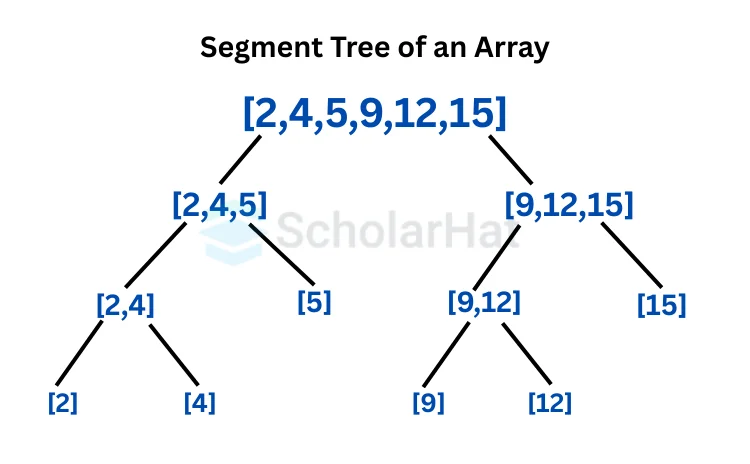14
DecSegment Tree in Data Structures: Operations, Advantages and Disadvantages
Segment Tree in Data Structures: An Overview
We saw that a Segment Tree is a tree data structure used for storing information about intervals, or segments in the section, Binary Trees in Data Structures.
In this DSA tutorial, we will learn the Segment trees in detail with their properties, applications, etc. Build a strong foundation for high-paying tech roles with DSA expertise. Enroll in our Free DSA Course today!
What is a Segment Tree in Data Structures?

A segment tree is a binary tree used to process different range queries over an array or another linear data structure. It has a divide-and-conquer approach. It breaks down an array or ranges into smaller segments, each containing a subset of the original data, creating a tree-like hierarchy. Here, each node represents a segment or range of array elements.
The root of the tree is a complete segment, i.e. carries information related to all the elements of the array. For the next level, this data in root is divided into two halves. The first half is assigned to the left subtree or the left child and the other half to the right one. This procedure is followed by subsequent nodes, recursively. The leaves in the tree hold individual elements of the array.
Creating a Segment Tree in Data Structures
class SegmentTree:
def __init__(self, V):
self.arr = V
self.tree = [0] * (4 * len(V))
self.build_tree(1, 0, len(V) - 1)
def build_tree(self, node, s, e):
if s == e:
self.tree[node] = self.arr[s]
return self.arr[s]
mid = s + (e - s) // 2
self.tree[node] = self.build_tree(2 * node, s, mid) + self.build_tree(2 * node + 1, mid + 1, e)
return self.tree[node]
def print_segment_tree(self):
print("Segment Tree:", end=" ")
for value in self.tree:
print(value, end=" ")
print()
if __name__ == "__main__":
input_array = [1, 2, 3, 4, 5]
seg_tree = SegmentTree(input_array)
# Now, the segment tree is built, and you can perform range queries and updates efficiently.
# Print the segment tree
seg_tree.print_segment_tree()
import java.util.Arrays;
import java.util.Vector;
public class SegmentTree {
private Vector arr, tree;
private int buildTree(int node, int s, int e) {
if (s == e) {
tree.setElementAt(arr.get(s), node);
return arr.get(s);
}
int mid = s + (e - s) / 2;
int leftSum = buildTree(2 * node, s, mid);
int rightSum = buildTree(2 * node + 1, mid + 1, e);
tree.setElementAt(leftSum + rightSum, node);
return tree.get(node);
}
public SegmentTree(Vector V) {
arr = V;
int max_size = 4 * V.size();
tree = new Vector<>(Arrays.asList(new Integer[max_size]));
Arrays.fill(tree.toArray(), 0);
buildTree(1, 0, V.size() - 1);
}
public void printSegmentTree() {
System.out.print("Segment Tree: ");
for (int value : tree) {
System.out.print(value + " ");
}
System.out.println();
}
public static void main(String[] args) {
// Example usage
Vector inputArray = new Vector<>(Arrays.asList(1, 2, 3, 4, 5));
SegmentTree segTree = new SegmentTree(inputArray);
// Now, the segment tree is built, and you can perform range queries and updates efficiently.
// Print the segment tree
segTree.printSegmentTree();
}
}
#include <iostream<
#include <vector<
using namespace std;
class SegmentTree {
private:
vector arr, tree;
int buildTree(int node, int s, int e) {
if (s == e) {
tree[node] = arr[s];
return arr[s];
}
int m = s + (e - s) / 2;
tree[node] = buildTree(node * 2, s, m) + buildTree(node * 2 + 1, m + 1, e);
return tree[node];
}
public:
SegmentTree(const vector& V) {
arr = V;
int max_size = 4 * V.size();
tree.resize(max_size);
buildTree(1, 0, V.size() - 1);
}
void printSegmentTree() const {
cout << "Segment Tree: ";
for (int value : tree) {
cout << value << " ";
}
cout << endl;
}
};
int main() {
// Example usage
vector inputArray = {1, 2, 3, 4, 5};
SegmentTree segTree(inputArray);
// Now, the segment tree is built, and you can perform range queries and updates efficiently.
// Print the segment tree
segTree.printSegmentTree();
return 0;
}
Output
Segment Tree: 0 15 6 9 3 3 4 5 1 2 0 0 0 0 0 0 0 0 0 0 Operations of Segment Trees
1) Update
The update operation takes in the new value to be set and the corresponding index. After making the update to the tree array, it needs to make similar relevant changes to the actual segment tree.
Example to perform update operation on Segment Trees
def update(tree, index, start, end, updateIndex, value):
if start == end:
# Leaf node, update the value
tree[index] = value
else:
mid = (start + end) // 2
# If the update index is in the left subtree
if updateIndex <= mid:
update(tree, 2 * index + 1, start, mid, updateIndex, value)
else:
# If the update index is in the right subtree
update(tree, 2 * index + 2, mid + 1, end, updateIndex, value)
# Recalculate the parent node value after updating the child nodes
tree[index] = tree[2 * index + 1] + tree[2 * index + 2]
def query(tree, index, start, end, queryStart, queryEnd):
if queryStart > end or queryEnd < start:
# The range is completely outside the current node's range
return 0
elif queryStart <= start and queryEnd >= end:
# The range is completely inside the current node's range
return tree[index]
else:
mid = (start + end) // 2
# Recursively query the left and right subtrees
leftSum = query(tree, 2 * index + 1, start, mid, queryStart, queryEnd)
rightSum = query(tree, 2 * index + 2, mid + 1, end, queryStart, queryEnd)
return leftSum + rightSum
arr = [1, 3, 5, 7, 9, 11]
# Build the segment tree
n = len(arr)
tree = [0] * (4 * n)
for i in range(n):
update(tree, 0, 0, n - 1, i, arr[i])
# Print the segment tree
print("Segment Tree:", end=" ")
for i in tree:
print(i, end=" ")
print()
# Perform an update operation
updateIndex = 2 # Index to update
newValue = 6 # New value to assign
update(tree, 0, 0, n - 1, updateIndex, newValue)
# Print the updated segment tree
print("Updated Segment Tree:", end=" ")
for i in tree:
print(i, end=" ")
print()
# Perform a range sum query
queryStart = 1 # Query start index
queryEnd = 4 # Query end index
summation = query(tree, 0, 0, n - 1, queryStart, queryEnd)
print(f"Sum from index {queryStart} to {queryEnd}: {summation}")
import java.util.Arrays;
class Main {
// Function to update a value in the segment tree
static void update(int[] tree, int index, int start, int end, int updateIndex, int value) {
if (start == end) {
// Leaf node, update the value
tree[index] = value;
} else {
int mid = (start + end) / 2;
// If the update index is in the left subtree
if (updateIndex <= mid) {
update(tree, 2 * index + 1, start, mid, updateIndex, value);
} else {
// If the update index is in the right subtree
update(tree, 2 * index + 2, mid + 1, end, updateIndex, value);
}
}
// Recalculate the parent node value after updating the child nodes
tree[index] = tree[2 * index + 1] + tree[2 * index + 2];
}
// Function to perform a range sum query in the segment tree
static int query(int[] tree, int index, int start, int end, int queryStart, int queryEnd) {
if (queryStart > end || queryEnd < start) {
// The range is completely outside the current node's range
return 0;
} else if (queryStart <= start && queryEnd >= end) {
// The range is completely inside the current node's range
return tree[index];
} else {
int mid = (start + end) / 2;
// Recursively query the left and right subtrees
int leftSum = query(tree, 2 * index + 1, start, mid, queryStart, queryEnd);
int rightSum = query(tree, 2 * index + 2, mid + 1, end, queryStart, queryEnd);
return leftSum + rightSum;
}
}
public static void main(String[] args) {
int[] arr = {1, 3, 5, 7, 9, 11};
// Build the segment tree
int n = arr.length;
int[] tree = new int[4 * n];
Arrays.fill(tree, 0);
for (int i = 0; i < n; ++i) {
update(tree, 0, 0, n - 1, i, arr[i]);
}
// Print the segment tree
System.out.print("Segment Tree: ");
for (int i = 0; i < tree.length; ++i) {
System.out.print(tree[i] + " ");
}
System.out.println();
// Perform an update operation
int updateIndex = 2; // Index to update
int newValue = 6; // New value to assign
update(tree, 0, 0, n - 1, updateIndex, newValue);
// Print the updated segment tree
System.out.print("Updated Segment Tree: ");
for (int i = 0; i < tree.length; ++i) {
System.out.print(tree[i] + " ");
}
System.out.println();
// Perform a range sum query
int queryStart = 1; // Query start index
int queryEnd = 4; // Query end index
int sum = query(tree, 0, 0, n - 1, queryStart, queryEnd);
System.out.println("Sum from index " + queryStart + " to " + queryEnd + ": " + sum);
}
}
#include <iostream>
#include <vector>
using namespace std;
// Function to update a value in the segment tree
void update(vector& tree, int index, int start, int end, int updateIndex, int value) {
if (start == end) {
// Leaf node, update the value
tree[index] = value;
} else {
int mid = (start + end) / 2;
// If the update index is in the left subtree
if (updateIndex <= mid) {
update(tree, 2 * index + 1, start, mid, updateIndex, value);
} else {
// If the update index is in the right subtree
update(tree, 2 * index + 2, mid + 1, end, updateIndex, value);
}
// Recalculate the parent node value after updating the child nodes
tree[index] = tree[2 * index + 1] + tree[2 * index + 2];
}
}
// Function to perform a range sum query in the segment tree
int query(vector& tree, int index, int start, int end, int queryStart, int queryEnd) {
if (queryStart > end || queryEnd < start) {
// The range is completely outside the current node's range
return 0;
} else if (queryStart <= start && queryEnd >= end) {
// The range is completely inside the current node's range
return tree[index];
} else {
int mid = (start + end) / 2;
// Recursively query the left and right subtrees
int leftSum = query(tree, 2 * index + 1, start, mid, queryStart, queryEnd);
int rightSum = query(tree, 2 * index + 2, mid + 1, end, queryStart, queryEnd);
return leftSum + rightSum;
}
}
int main() {
vector arr = {1, 3, 5, 7, 9, 11};
// Build the segment tree
int n = arr.size();
vector tree(4 * n);
for (int i = 0; i < n; ++i) {
update(tree, 0, 0, n - 1, i, arr[i]);
}
// Print the segment tree
cout << "Segment Tree: ";
for (int i = 0; i < tree.size(); ++i) {
cout << tree[i] << " ";
}
cout << endl;
// Perform an update operation
int updateIndex = 2; // Index to update
int newValue = 6; // New value to assign
update(tree, 0, 0, n - 1, updateIndex, newValue);
// Print the updated segment tree
cout << "Updated Segment Tree: ";
for (int i = 0; i < tree.size(); ++i) {
cout << tree[i] << " ";
}
cout << endl;
// Perform a range sum query
int queryStart = 1; // Query start index
int queryEnd = 4; // Query end index
int sum = query(tree, 0, 0, n - 1, queryStart, queryEnd);
cout << "Sum from index " << queryStart << " to " << queryEnd << ": " << sum << endl;
return 0;
}
Output
Segment Tree: 36 9 27 4 5 16 11 1 3 0 0 7 9 0 0 0 0 0 0 0 0 0 0 0
Updated Segment Tree: 37 10 27 4 6 16 11 1 3 0 0 7 9 0 0 0 0 0 0 0 0 0 0 0
Sum from index 1 to 4: 25 2) Query
The query() function takes in as parameters the boundaries of the query, l and r, and returns the sum of the elements in this range of l and r in the array.
Example to perform query operation on Segment Trees
import math
def buildSegmentTree(arr, segmentTree, low, high, pos):
if low == high:
segmentTree[pos] = arr[low]
return
mid = low + (high - low) // 2
buildSegmentTree(arr, segmentTree, low, mid, 2 * pos + 1)
buildSegmentTree(arr, segmentTree, mid + 1, high, 2 * pos + 2)
segmentTree[pos] = segmentTree[2 * pos + 1] + segmentTree[2 * pos + 2]
def query(segmentTree, qlow, qhigh, low, high, pos):
if qlow <= low and qhigh >= high:
return segmentTree[pos]
if qlow > high or qhigh < low:
return 0
mid = low + (high - low) // 2
return query(segmentTree, qlow, qhigh, low, mid, 2 * pos + 1) + query(segmentTree, qlow, qhigh, mid + 1, high, 2 * pos + 2)
# Example usage
arr = [1, 3, 5, 7, 9, 11]
n = len(arr)
# Calculate the size of the segment tree
treeSize = 2 * (2 ** (math.ceil(math.log2(n)))) - 1
# Create the segment tree
segmentTree = [0] * treeSize
# Build the segment tree
buildSegmentTree(arr, segmentTree, 0, n - 1, 0)
# Perform a query (example range [2, 4])
qlow, qhigh = 2, 4
summation = query(segmentTree, qlow, qhigh, 0, n - 1, 0)
print("Sum of elements in the given range:", summation)
import java.util.Arrays;
class Main {
// Function to build the segment tree
static void buildSegmentTree(int[] arr, int[] segmentTree, int low, int high, int pos) {
if (low == high) {
segmentTree[pos] = arr[low];
return;
}
int mid = low + (high - low) / 2;
buildSegmentTree(arr, segmentTree, low, mid, 2 * pos + 1);
buildSegmentTree(arr, segmentTree, mid + 1, high, 2 * pos + 2);
segmentTree[pos] = segmentTree[2 * pos + 1] + segmentTree[2 * pos + 2];
}
// Function to perform the query operation
static int query(int[] segmentTree, int qlow, int qhigh, int low, int high, int pos) {
if (qlow <= low && qhigh >= high) {
return segmentTree[pos];
}
if (qlow > high || qhigh < low) {
return 0;
}
int mid = low + (high - low) / 2;
return query(segmentTree, qlow, qhigh, low, mid, 2 * pos + 1) +
query(segmentTree, qlow, qhigh, mid + 1, high, 2 * pos + 2);
}
public static void main(String[] args) {
int[] arr = {1, 3, 5, 7, 9, 11};
int n = arr.length;
// Calculate the size of the segment tree
int treeSize = 2 * (int)Math.pow(2, Math.ceil(Math.log(n) / Math.log(2))) - 1;
// Create the segment tree
int[] segmentTree = new int[treeSize];
// Build the segment tree
buildSegmentTree(arr, segmentTree, 0, n - 1, 0);
// Perform a query (example range [2, 4])
int qlow = 2, qhigh = 4;
int sum = query(segmentTree, qlow, qhigh, 0, n - 1, 0);
System.out.println("Sum of elements in the given range: " + sum);
}
}
#include <iostream>
#include <vector>
#include <cmath>
using namespace std;
void buildSegmentTree(const vector& arr, vector& segmentTree, int low, int high, int pos) {
if (low == high) {
segmentTree[pos] = arr[low];
return;
}
int mid = low + (high - low) / 2;
buildSegmentTree(arr, segmentTree, low, mid, 2 * pos + 1);
buildSegmentTree(arr, segmentTree, mid + 1, high, 2 * pos + 2);
segmentTree[pos] = segmentTree[2 * pos + 1] + segmentTree[2 * pos + 2];
}
int query(const vector& segmentTree, int qlow, int qhigh, int low, int high, int pos) {
if (qlow <= low && qhigh >= high) {
return segmentTree[pos];
}
if (qlow > high || qhigh < low) {
return 0;
}
int mid = low + (high - low) / 2;
return query(segmentTree, qlow, qhigh, low, mid, 2 * pos + 1) + query(segmentTree, qlow, qhigh, mid + 1, high, 2 * pos + 2);
}
int main() {
vector arr = {1, 3, 5, 7, 9, 11};
int n = arr.size();
// Calculate the size of the segment tree
int treeSize = 2 * (int)pow(2, ceil(log2(n))) - 1;
// Create the segment tree
vector segmentTree(treeSize);
// Build the segment tree
buildSegmentTree(arr, segmentTree, 0, n - 1, 0);
// Perform a query (example range [2, 4])
int qlow = 2, qhigh = 4;
int sum = query(segmentTree, qlow, qhigh, 0, n - 1, 0);
cout << "Sum of elements in the given range: " << sum << endl;
return 0;
}
Output
Sum of elements in the given range: 21
Read More - Best Data Structure Interview Questions and Answers
Complexity Analysis of Operations on Segment Trees
- Time Complexity
Operations Time Complexity Construction O(n) Query O(log n) Update O(log n) - Space Complexity: The space complexity of a segment tree is O(n).
Here n is the number of elements put in the tree
Advantages of Segment Trees
- Efficient Range Queries: Segment trees excel at performing range queries on dynamic arrays or sequences. They allow you to answer queries about a specific range of elements in logarithmic time complexity O(log n), regardless of the size of the array.
- Dynamic Updates: Segment trees can efficiently handle updates to the elements of an array or sequence. Whether it's modifying a single element or updating a range of values, segment trees can perform these updates in logarithmic time complexity.
- Versatility: Segment trees are flexible and adaptable. They can be used for various types of data, such as integers, floating-point numbers, or even non-numeric values, as long as you define appropriate operations for the data type.
- Space Efficiency: Although segment trees require additional memory to store the tree structure, they typically provide a space-efficient solution.
- Range Decomposition: Segment trees naturally decompose an array or sequence into smaller segments, allowing for efficient recursive processing. This property makes them useful in divide-and-conquer algorithms, where problems are divided into smaller subproblems, solved recursively, and then combined to obtain the final result.
Disadvantages of Segment Trees
- Space Complexity: Segment trees require additional space to store the tree structure, which can be a disadvantage in scenarios where memory usage is a concern.
- Construction Time: Building a segment tree can take a significant amount of time, especially when the input array is large. The construction process involves recursively dividing the array into smaller segments and performing operations to build the tree.
- Updates and Modifications: Although segment trees excel at querying and computing aggregate functions over a range of elements efficiently, updating or modifying individual elements can be more time-consuming. When an element in the input array changes, the corresponding segment tree needs to be updated to reflect the modification, which can require traversing multiple tree nodes.
- Complex Implementation: Implementing a segment tree can be challenging compared to simpler data structures. The recursive nature of segment trees and the need for efficient indexing can make the code more intricate and error-prone.
Summary
So, here we saw all the aspects of segment trees in data structures. It's quite a difficult concept and hence requires a good amount of time to understand the concepts. To test your knowledge of segment trees, enroll in our Free Best Dsa Course.
Top developers are already moving into Solution Architect roles. If you stay just a “coder,” you’ll be stuck while they lead. Enroll now in our Java Solution Architect Certification and step up.
FAQs
Take our Datastructures skill challenge to evaluate yourself!

In less than 5 minutes, with our skill challenge, you can identify your knowledge gaps and strengths in a given skill.












